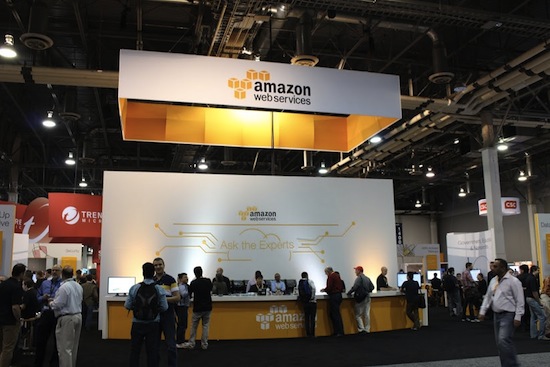Why AWS' revenue revelation is significant
By Edwin Yapp April 30, 2015
- Finally reveals financial numbers, proving it has a viable cloud business
- Shows profitability and leadership for now but rivals targeting market share

NEWS ANALYSIS AMAZON Web Services (AWS) recently revealed financial figures for the first time since its birth in 2006, a move that was very significant.
The world’s largest cloud computing service provider, a wholly owned division of Amazon.com Inc, revealed a two-year historical breakdown of its revenue and profit figures, a move that gave analysts and investors unprecedented insights into the unit’s performance.
AWS said it recorded US$1.57 billion revenue for the first quarter ending March 2015, up almost 50% from US$1.05 billion a year ago.
It also reported a healthy US$265-million operating income (and a 16.9% operating margin), a larger than expected figure. Operating income takes the gross income, defined by revenue, and subtracts the cost of goods sold (COGS) and other operating expenses.
For 2014, AWS recorded US$4.644 billion in revenue versus US$3.984 billion in COGS, for a US$660 million operating income. For 2013, it recorded US$3.108 billion in revenue with US$2.435 billion in COGS, for an operating income of US$673 million.
That means that AWS revenue and profit grew about 49% and 2% respectively in 2014 over 2013.
Industry and financial analysts, as well as investors, have for years criticised the Seattle, Washington-based web giant for not breaking out its cloud division’s financial numbers.
Things weren’t that bad when Amazon reported year-on-year growth. But the antsy feeling investors experienced began in the second quarter of 2014, when AWS’ parent Amazon.com reported its largest quarterly loss since 2012 as operating expenses rose 24%, led by a 40% surge in spending on technology and content, according to Reuters.
These feelings reached their zenith in October 2014 when Amazon.com missed the mark on its third quarter earnings. The company reported a net loss of US$437 million, compared with a net loss of US$41 million in the same period the previous year, according to Forbes.
The issue of profitability has dogged AWS for some time now. Financial analysts last year said that there were fundamental signs of trouble, exacerbated by the fact that AWS does not reveal how much sales it rakes in or whether it’s profitable already, preferring to focus on its overall growth in percentage terms and the size of its customer base.
Various analysts have tried figuring these numbers out and while there isn’t any scientific accuracy to this exercise, the general consensus is that AWS makes between US$4 and US$5 billion a year.
However, the unknown variable is how much expenditure it has, making it hard to determine if it’s profitable or not.
 At AWS’ re:Invent customer and partner summit in Las Vegas last November, Andy Jassy (pic), senior vice president of the cloud arm of Amazon.com Inc, resisted calls to reveal exact revenue and profit numbers.
At AWS’ re:Invent customer and partner summit in Las Vegas last November, Andy Jassy (pic), senior vice president of the cloud arm of Amazon.com Inc, resisted calls to reveal exact revenue and profit numbers.
He said then that he believes AWS has the potential to be the largest business for Amazon.com in the long term, which says a lot given that its retail parent records over US$70 billion in revenue.
“We’re extremely pleased with our business and our progress,” he declared. “We believe that AWS has the potential to be the biggest business for the company, and so we will continue to invest.”
When asked when the company will come out of ‘investment mode,’ and whether the issue of profitability would stymie plans to grow, Jassy said that AWS is confident that this is the right model for years to come, and that it can fund this business the way it deserves.
But the online giant softened its hardline stance against making its revenue and profit numbers public last December when it indicated that it would break out its results in 2015 for the first time, reports Reuters.
The news agency said that this shift is a good sign for investors, who have been clamouring for Amazon to disclose more about its fastest-growing and likely most profitable division that some analysts estimate contributes about 4% of its total revenue.
What numbers may mean
Overall, analysts and investors greeted the news of AWS’ profitability with enthusiasm, sending its parent’s stocks higher. Amazon.com shares rose US$26.01 to US$416 in extended trading on the news of its profitability on April 23, after closing slightly higher at US$389.99 on Nasdaq.
Reuters also quoted Wedbush Securities analyst Michael Pachter as saying, “AWS is profitable, and apparently was a year ago as well. Everybody thought it was losing money ... and [its revenue] is probably a bit smaller than people thought it was.”
Michael Warrilow, research director at firm Gartner, believes that in many ways, the results legitimise the infrastructure-as-a-service (IaaS) market, showing that cloud players like AWS and Microsoft Corp’s Azure can make money.
When asked what the results mean to AWS and its impact on the market, he said they show that “Amazon.com could spin out AWS as a distinct business, if it ever needed to.”
“For me though, the more important thing to note is that it shows that it is not in a ‘race to the bottom’ for AWS, as some of the traditional IT vendors have claimed it would be,” he said told Digital News Asia (DNA) via email.
“This is a good sign for AWS, given that its operating income is positive and its revenue has strong growth, and that Gartner’s forecasts for IaaS is expected to grow strongly through 2019,” he added.
Competitors up ante
.jpg)
Despite the auspicious signs for AWS, some industry watchers have warned that its competitors aren’t resting on their laurels and have trained their guns squarely on the cloud computing leader.
Nipping at its heels is Google Inc’s public cloud offering Google Compute Engine (GCE), which the search giant made publicly available in December 2013. Google has the scale and ambition to take on AWS, and while the latter is still the undisputed king, customers may not like to be locked into only one player.
And then there is Microsoft’s Azure platform, which started out as a Platform-as-a-Service (PaaS) offering, but has since grown to become a dominant IaaS player.
The same goes for IBM, which acquired SoftLayer in 2013.
In fact, the rise of these players has forced AWS to lower its prices 45 times, as at the end of 2014, since its inception.
According to the New York Times, Microsoft said its commercial cloud revenue grew 106% during the last quarter, and that it “amounted to a US$6.3-billion annual business based on its recent performance.”
The daily however noted that the Redmond, Washington-based company also includes revenue from different online applications into that figure.
Its revenue from Azure itself, which is more directly comparable to Amazon’s cloud services, was recently estimated by Deutsche Bank to be as little as one-tenth of that of AWS’, The Times reported.
 When asked on the significance of the reported numbers, Gartner’s Warrilow (pic) said that it’s hard to make a direct apple-to-apple comparison between the two.
When asked on the significance of the reported numbers, Gartner’s Warrilow (pic) said that it’s hard to make a direct apple-to-apple comparison between the two.
“On a like-for-like comparison, Microsoft and Google do not come close to AWS revenue,” he said.
“[But] given that AWS is the first [vendor] to break out and disclose its cloud revenue in this way, making comparisons with other competitors in some ways is difficult,” he added.
Still, the battleground has been set and AWS’ detailed revenue figures show that it is the company to catch in the public cloud computing services space.
This is why at last year’s re:Invent, it took great pains to outline its strategy to target large enterprises with its new feature sets, software and tools, and stressed price cuts.
READ ALSO: Can Amazon Web Services serve enterprises effectively?
The New York Times also reported that industry analysts believe Microsoft has a better chance of persuading large businesses already using its software products to adopt its cloud services.
“Enterprise customers buy a certain way – they have compliance and contracting processes,” said Matt McIlwain, a venture capitalist with Madrona Venture Group.
“They don’t just adopt the newest, most innovative thing. And there is a whole bunch of incumbents, from IBM to HP (Hewlett-Packard), that already count those companies as customers.”
Gartner’s Warrilow concurs, saying that right now, AWS’ biggest obstacle is enterprises’ growing frustration in engaging with AWS.
“Its engagement model is very different from traditional IT suppliers in terms of contracts, services, and relationships, for instance,” he said.
Warrilow said that AWS operates in a new and different model as it provides little flexibility in its contracts, and has a different way of managing accounts.
“This is neither good nor bad, just different. However, it is proving to frustrate larger organisations that are used to dealing with traditional IT vendors,” he said.
As for lowering its pricing structure, Warrilow believes that as long as AWS can keep clawing greater efficiencies from its platform, it can afford to keep cutting costs without reducing profit.
“In the long term, every infrastructure vendor will be targeting AWS, but for now, it remains in good shape and still has unique technical advantages for years to come,” he added.
Related Stories:
Businesses still figuring out their cloud strategy: NetApp CTO
SingTel in Azure pact with Microsoft
2014 in Review: Cloud computing comes of age
VMware targets Microsoft and AWS with OneCloud
For more technology news and the latest updates, follow us on Twitter, LinkedIn or Like us on Facebook.


